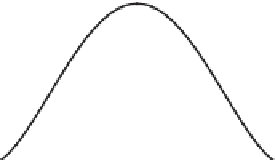Geography Reference
In-Depth Information
explored in Section 4.7, but is recapped here to illustrate KE. h e KE of intensity is
given by:
xx
-
n
1
Ê
ˆ
ˆ
Â
l
()
x
=
k
i
(7.6)
Á
˜
k
t
2
Ë
t
¯
i
=
1
where
t
is the bandwidth (determining the size of the kernel, see Section 8.4 for a
related discussion) and
x
-
x
i
indicates the distance between the centre of the kernel (
x
)
and the location
x
i
. A kernel function is used to give larger weights to nearby events
(points) than events that are more distant.
h ere is a variety of dif erent kernels that have been used for KE. h e quartic
kernel is encountered frequently in the point pattern analysis literature (Bailey and
Gatrell, 1995):
3
(1
Ï
T
2
T
-
uu
) f o r
uu
£
1
=
Ì
Ó
(7.7)
k
()
u
p
0 otherwise
where
u
is
d
i
/
t
and
d
i
is the distance from the centre of the kernel, and superscript
T
indi-
cates the transpose of the matrix (see Appendix A for a dei nition). In short, values are
summed for all cases where the distance is less than or equal to the bandwidth. h e quar-
tic kernel is illustrated in Figure 7.8 and a section through the quartic kernel is shown
in Figure 7.9. h e KE with the quartic kernel can be given by (Bailey and Gatrell, 1995):
2
Ê
2
ˆ
3
d
ˆ
Â
l
()
x
=
1
-
i
(7.8)
Á
˜
k
2
2
pt
t
Ë
¯
d
£
t
i
h e application of this equation is outlined below.
h e naïve estimator and a kernel estimator are illustrated with reference to two sets
of points, labelled A and B, in Figure 7.10. We will take each set as a subset (contained
x
τ
Event location
Figure 7.8
Quartic weighting scheme, with bandwidth
t
.















































Search WWH ::

Custom Search